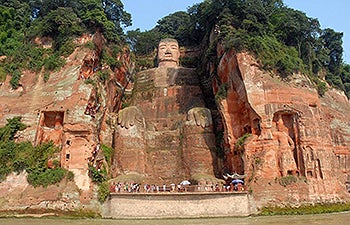Finding Light in a Cave
Sonya Lee became interested in cave temples in China when she was a teenager and has studied them extensively. Lee analyzes the architecture and artifacts found at these sites, many of which are more than a thousand years old.
Now Lee, an associate professor of art history, East Asian languages and cultures, and religion at USC Dornsife, has been awarded a three-year Mellon Foundation New Directions Fellowship to support her research in the emerging field of eco–art history. The grant will allow her to pursue specialized technical training in heritage conservation, which she will apply to her research on ancient Chinese cave temples. Some inscribed as UNESCO World Heritage sites or as protected cultural properties in China, these cave temples are often located along mountain ranges or next to rivers.
Lee examines the development of cultural monuments over time and analyzes their contemporary relevance through art historical research, conservation science, application of digital technologies and international collaboration.
“I’m very honored by this award because it’s one of the most difficult fellowships for someone working in the humanities and social sciences to get,” Lee said. “I feel very gratified that people see the importance of this type of research. I’m also grateful to colleagues in the dean’s office who helped me with the preparation of the budget and the proposal.”
New Directions Fellowships support serious interdisciplinary research that requires formal training in an area other than the fellow’s chosen field. The fellowships assist humanities and social sciences faculty members who seek advanced training to carry out specific research. The fellowship is meant to benefit scholarship by encouraging the highest standards in interdisciplinary research.
Cave temples are ideal for an earth-centered approach in art history that explores the interrelationship between art and the environment. This new methodology, known as eco–art history, stresses the interconnectedness of cultural monuments to their social context and ecosphere. Lee will examine how the natural setting shaped the design of a cave temple and how the site has changed the way the surrounding community has come to understand this landscape over time.
China is a particularly fertile ground for research in eco–art history. Not only does the country have the world’s highest concentration of cave temples, but many of these structures have survived intact and with ample documentation about their creation and reception in subsequent periods.

Pictured is the Maitreya Buddha at Lingyun Temple, located near the city of Leshan in the southern part of China’s Sichuan province. Begun in the 8th century, the statue is 233 feet tall and the largest stone Buddha in the world. Image courtesy of Sonya Lee.
“Eco-art history is an approach and a methodology that brings the environment into art historical scholarship,” Lee said. “People have been fascinated by nature for a long time, and artists claim to get inspiration from nature. In a way I’m trying to say that art historians should get inspiration from nature as well.”
Thus far Lee’s research has focused primarily on historical interpretations of written records and material objects. But to further explore the ever-evolving relationship between cave temples and their immediate environs, she believes that understanding the physical properties and climatic setting of these structures from a more scientific perspective is crucial.
To that end, Lee will complete advanced training in Italy as well as in the master’s program in Conservation of Archaeological and Ethnographic Materials, jointly offered by UCLA Cotsen Institute of Archaeology and the Getty Conservation Institute in Los Angeles. Coursework will focus on scientific conservation of materials, principles, practices and ethics in conservation, and specialized study of materials such as stone, organic materials and metal.
This training will give her a firmer grasp of heritage conservation and allow her to incorporate scientific data into her work. This quantitative analysis will in turn enrich the historical interpretations drawn from her humanities-based research, more fully realizing the potential of eco–art history.
“Learning about the methods and science of heritage conservation, and getting practical knowledge about designing and implementing projects will be very key. It’s bringing art and science together.”
Lee believes that eco–art history offers an ideal framework within which to bring the disciplines of art history and conservation into a dialogue.
“In the study of art history or literature, people tend to focus on the creation of things,” Lee said. “I’m more interested in the reception and ongoing development of these creations over time. When you change focus from when and why things are made to how later generations are preserving these things, it raises questions about contemporary relevance as well as notions of cultural heritage — how we make use of ideas and material objects from the past for present needs.
“I’d like to break away from the dichotomy you see so often in the humanities, where people tend to specialize in, say, the 15th century or the modern period. In my research, I’m trying to stretch the historical dimensions of art both forward and backward in time.”
Lee is the recipient of other prestigious fellowships and research grants from such organizations as the National Gallery of Art in Washington D.C., Getty Foundation, Japan Foundation, Chiang Ching-kuo Foundation, American Council of Learned Societies and the Asian Cultural Council.